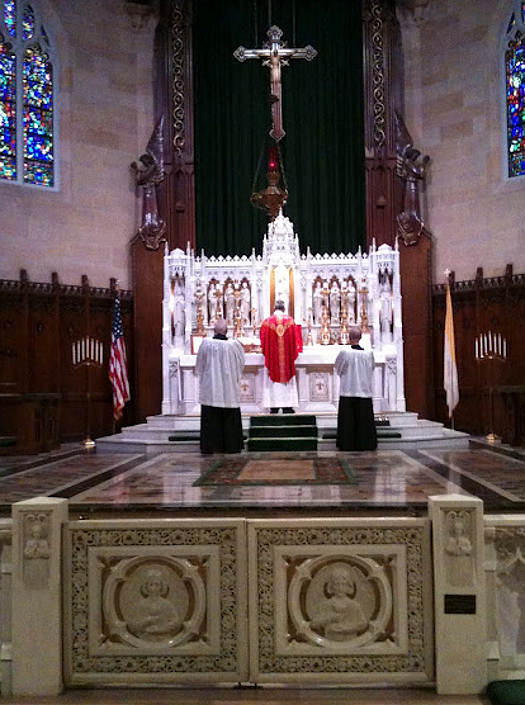 Det er nok en stund til slike ting begynner å skje i Norge, men i andre land begynner det nå langsomt; at bordalter som ble plassert i kirkenes kor på 70-tallet, nå tas bort. Dette eksempelet er fra the Assumtion Grotto i Detroit, der sognepresten skriver bl.a.:
Det er nok en stund til slike ting begynner å skje i Norge, men i andre land begynner det nå langsomt; at bordalter som ble plassert i kirkenes kor på 70-tallet, nå tas bort. Dette eksempelet er fra the Assumtion Grotto i Detroit, der sognepresten skriver bl.a.:
… many of you, though not all, noticed a change in the sanctuary of the church last weekend. The low altar had been removed, allowing the high altar to shine in its full original splendor. Although I had intended to write to you about this in advance of its ouster, events moved too swiftly for me to do that. Our Parish Council members had been foretold of this intention sometime ago. No one then showed any dissatisfaction with the proposal. Indeed, everyone seemed intrigued to know how the church would have looked at its construction. I offer a brief ‘unscientific’ history of this subject.
… After the Second Vatican Council there was a popular movement in liturgical circles to have the Mass celebrated with the priest facing the people, even though this was never mandated by the Council nor by any subsequent directive of the Holy See. Grotto Church, like most others, began the practice with a temporary altar set up in the great open space before the high altar (which space had been created for the old solemn ceremonies of the Latin liturgy) so that a priest could celebrate Mass towards the people. … In 1978 Monsignor Sawher decided to replace the temporary low altar with a dignified and indeed beautiful marble altar that would in many ways be harmonious with the existing decor.
When I carefully studied the book The Spirit of the Liturgy by then-Cardinal Ratzinger (now Pope Benedict XVI), I realized that we ought to be facing East once again and not towards the people since that position inadvertently created a “closed circle” that did not aim towards heaven, towards God (East), but towards man (symbolically indicating that man and not God was the focal point of the Mass). In the early years of my pastorship here, the low altar was used variously: first, facing the people; then facing East; and then, with a move of the altar farther back some feet towards the main altar, with the priest still facing East. We were getting progressively more in line with an ideal.
… Fine, you may say, but what is to be done should a visiting priest want to celebrate Mass facing the people? We have already provided for that in having readily available an altar that can be set in place in a matter of minutes. It too is suitably made, containing an true altar stone and thus worthy of Holy Mass.
